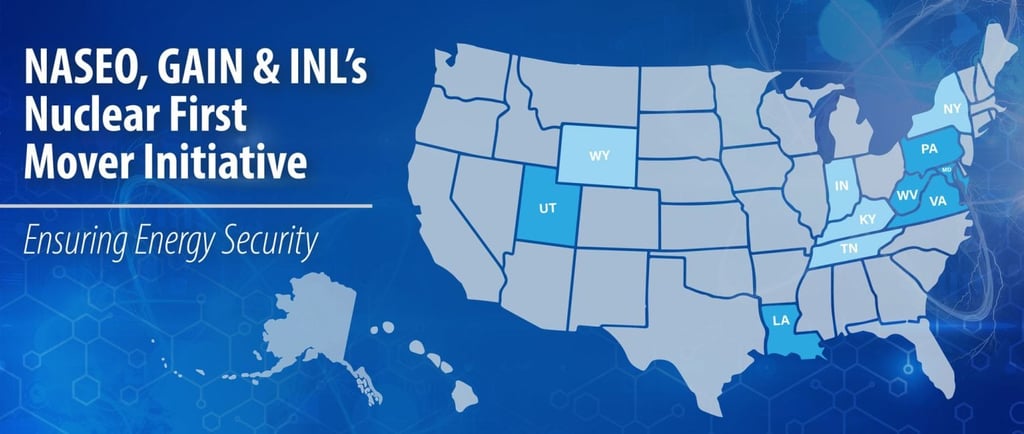While Other States Build Reactors, Ohio Misses the Moment
The Trump administration is backing a nuclear revival—billions in funding, fuel line pilots, and a mandate to deploy advanced reactors by 2026. 🚀 Kentucky, Texas, and Tennessee are sprinting ahead. ⚙️ Ohio? Still stuck in neutral.
NEWS
Nancy Carrington
8/6/20254 min read


By Nancy Carrington | eGen News | August 6, 2025
WEST CHESTER, OHIO — Across the country, America is waking up to nuclear energy's second age. But in Ohio—once a titan of industrial resolve—the gears are grinding slowly, even as a national nuclear renaissance roars to life.
While Paducah, Kentucky, just secured a $1.5 billion deal to restart uranium enrichment with Peter Thiel-backed startup General Matter, and while Tennessee and Texas sprint to deploy advanced nuclear reactors (ANRs) with full state support, Ohio lawmakers remain inexplicably silent. As dozens of states mobilize to attract investment, tech infrastructure, and clean baseload energy, Ohio—a state rich in talent, land, grid capacity, and nuclear history—is at risk of becoming a spectator.
A Tidal Wave of Policy Support—But Not in Columbus
Let’s be clear: The Trump administration has declared nuclear energy a national security priority.
Under a July 2025 executive order, President Trump directed the U.S. Department of Energy (DOE) to deploy at least three advanced nuclear reactors by July 4, 2026, build out a domestic fuel supply chain, and establish pilot programs to jumpstart both enrichment and fabrication of new fuel types like HALEU and TRISO.
Already, we’re seeing results:
The DOE selected Standard Nuclear of Oak Ridge, TN as the first fuel line pilot program recipient, accelerating TRISO fuel production.
Kentucky secured a long-term lease at the historic Paducah Gaseous Diffusion Plant, reestablishing HALEU enrichment on U.S. soil by 2030.
Texas, Virginia, Indiana, and Utah have established dedicated nuclear funds, permitting reforms, and SMR incentive programs.
Eleven states formed the Advanced Nuclear First Mover Initiative, working together to create shared infrastructure and standardized deployment.
Where is Ohio in all this?
Ohio’s Untapped Potential: A Sleeping Giant
Ohio already has:
The Davis-Besse and Perry nuclear power plants are ideal sites for the co-location of advanced SMRs.
The former Piketon Uranium Gaseous Diffusion Facility is a prime location for advanced Nuclear Reactor Demonstration Plants
A powerful manufacturing base.
Proximity to national labs and heavy research universities.
A grid hungry for reliable, baseload power to support AI data centers, hydrogen hubs, and advanced manufacturing.
But while places like Wyoming and Arkansas pass bold cost-recovery legislation and create regulatory fast lanes for small modular reactors (SMRs), Ohio’s General Assembly has yet to act. No CWIP (Construction Work in Progress) reforms - Construction Work in Progress (CWIP) allows monopoly utility companies to charge customers for power plants and other infrastructure before they’re built or operational. These costs are passed along during construction, not after a plant provides electricity. No nuclear development fund. No state-level siting initiatives. No BTM (Behind the Meter) PPAs (Power Purchase Agreements with Electric or Electric Distribution Utilities. No organized push from the Governor’s office. It’s as if the future showed up on our doorstep... and we didn’t answer the door.
What’s Working Elsewhere—and Why It Matters
Virginia is investing in nuclear workforce development and partnering with Amazon on SMRs.
Utah, Idaho, and Wyoming are drafting a joint deployment strategy for multi-state nuclear expansion.
New York has mandated 1 GW of new nuclear generation, coupling it with feasibility studies and grid integration planning.
Texas has opened the taps with over $350 million in new funding for nuclear innovation.
North Carolina just passed legislation to recover nuclear project costs during construction, a major catalyst for private investment.
Why does this matter? Because nuclear power is no longer just about electricity. It’s about sovereignty, infrastructure, and economic growth. Every new reactor is a promise: of clean power, of skilled jobs, of industrial revival.
And it’s a promise Ohio is in danger of breaking.
A Fork in the Road: Build Reactors, or Watch Others Reap the Benefits
The future isn’t waiting.
Peter Thiel-backed General Matter is already preparing to enrich HALEU fuel by 2030 in Kentucky. In Oak Ridge, Standard Nuclear is pumping out TRISO fuel for microreactors and next-gen power systems. In Tennessee, Kairos Power is demonstrating the Hermes reactor, and TVA is laying the groundwork for multiple BWRX-300s.
In other words, America is already moving down the field. The ball is in play. The refs have blown the whistle. The only question is whether Ohio will join the game—or stay on the sidelines.
What Ohio Must Do Now
Fund the Ohio Nuclear Development Authority, with a mandate to attract funding, coordinate stakeholders, and push permitting reform.
Pass construction cost recovery (Cwip) legislation to enable utilities and developers to invest in projects without bearing all upfront risk.
Establish a nuclear innovation grant fund, focused on workforce training, site readiness, and supply chain development.
Signal loudly through the ONDA to developers and hyperscalers that Ohio is open for nuclear business.
Other states are already pitching themselves to data centers and reactor vendors: “We have the policies, the permits, and the people.” Ohio has the people. We need the rest.
Final Word: There’s Still Time to Lead
This is not just a technology race. It’s a leadership test.
If Ohio wants to be a serious player in the next century’s energy economy—if we want the jobs, the grid resilience, the manufacturing boom—then the time for legislative drift is over.
The football has been moved 90 yards downfield by federal action, private capital, and forward-thinking states. All Ohio has to do is punch it into the end zone.
But that takes political courage. And it takes action—now.


Ohio is literally surrounded by states that have joined the Advanced Nuclear First Mover Initiative


